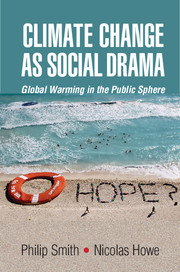Book contents
- Frontmatter
- Contents
- Acknowledgments
- 1 Introduction: The Problem of Climate Change
- 2 Climate Change as Social Drama
- 3 Narrating Global Warming
- 4 An Inconvenient Truth: The Power of Ethos
- 5 Climate Change Art: An Illustrative Failure?
- 6 Climategate and Other Controversies
- 7 The Climate Conference as Theatre
- 8 Local Dramas: The Places of Climate Change
- 9 Conclusion: The Show Must Go On
- References
- Index
7 - The Climate Conference as Theatre
Published online by Cambridge University Press: 05 May 2015
- Frontmatter
- Contents
- Acknowledgments
- 1 Introduction: The Problem of Climate Change
- 2 Climate Change as Social Drama
- 3 Narrating Global Warming
- 4 An Inconvenient Truth: The Power of Ethos
- 5 Climate Change Art: An Illustrative Failure?
- 6 Climategate and Other Controversies
- 7 The Climate Conference as Theatre
- 8 Local Dramas: The Places of Climate Change
- 9 Conclusion: The Show Must Go On
- References
- Index
Summary
We have spoken throughout this book of climate change as amenable to fruitful analysis as a drama. Nowhere is this claim more obvious than in the case of climate change conferences. Yet as we show in this chapter, the theatricality of climate conferences is surprisingly multifaceted and marked by a high degree of what Victor Turner called “performative reflexivity” (see Chapter 2). These are no mere dog-and-pony shows. Of course, such meetings have bureaucratic and legislative activities that are to some extent hidden or “backstage,” and policy experts are apt to depict this backstage deal making as “where the action really happens.” Still the drama analogy holds along a surprising number of dimensions. We begin by noting that conventions and conferences have ritual aspects. As Lyn Spillman (2012) shows in her discussion of American business association annual meetings, even the most humdrum get together of concrete engineers or rubber glove makers will have a solidaristic and civic component. This is enacted and reproduced through performative gestures like memorials, award ceremonies, charity auctions, and dinner cruises. She writes that in such events, “many contemporary associations demonstrate camaraderie well above and beyond the pursuit of shared interests” (169). So conferences and congresses are like rituals. And from ritual to drama is but a short step, as Nietzsche – echoing Aristotle's prior analysis – showed in his interpretation of Greek civilization.
The analogies are manifold. Indeed, strictly considered, they are not even analogies but shared properties. Like staged dramas, conferences take place in a defined location (a city, a convention center) and exist for a predetermined period of time. These are places where people perform to each other to make claims and to demonstrate their good character. The guaranteed presence of the global mass media makes the effort involved in performing well an even better investment. So politicians and activists work hard to tell stories, to display competence and talent, and to relay facts to the onlooking global audience.
- Type
- Chapter
- Information
- Climate Change as Social DramaGlobal Warming in the Public Sphere, pp. 145 - 165Publisher: Cambridge University PressPrint publication year: 2015

